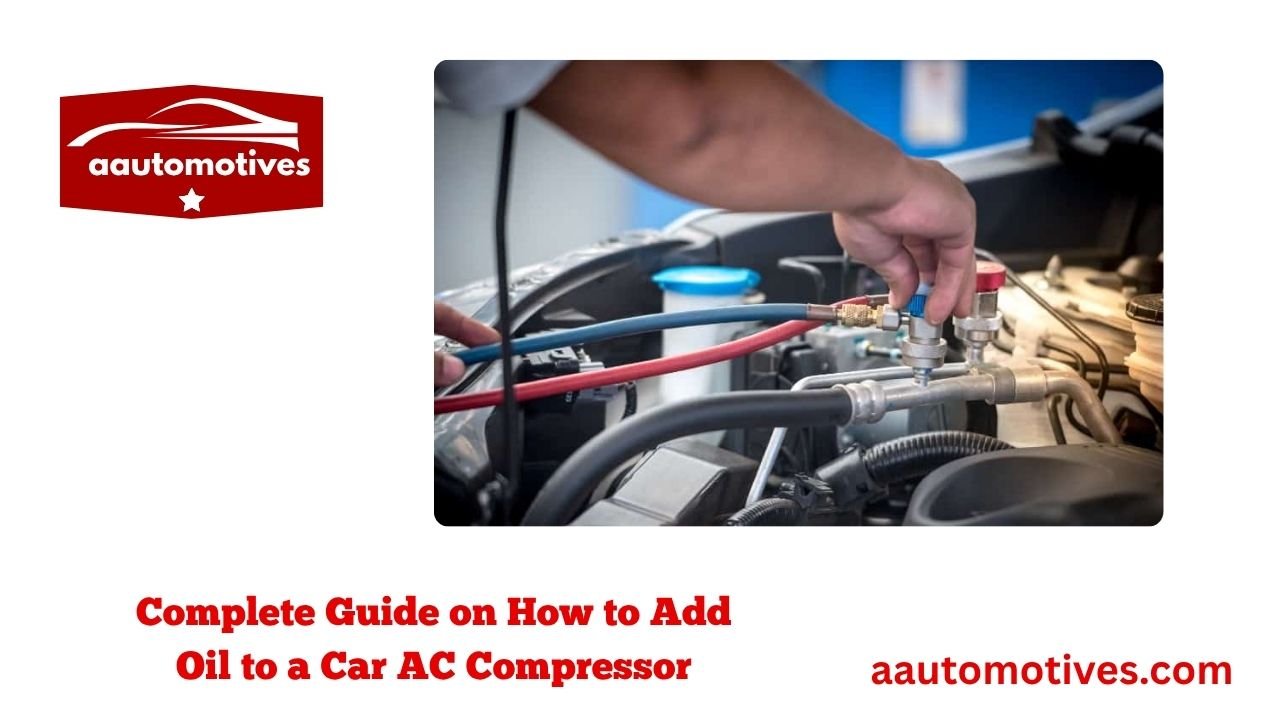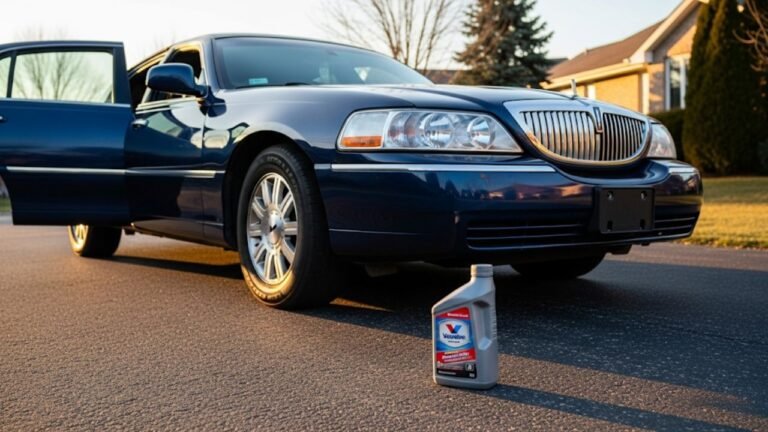Complete Guide on How to Add Oil to a Car AC Compressor

Let me take you back to one of those scorching summer days—yes, the kind that makes your T-shirt stick to your back within minutes. I jumped into my car, hoping for that blessed chill from the air conditioner. But instead of cool air, I got a lukewarm breeze, like someone breathing on me through a straw. I knew something was off. After some digging, I realized my AC compressor was dry—low on oil. That’s when I learned the importance of knowing how to add oil to a car AC compressor.
Whether you’re a weekend DIY-er or someone trying to avoid a huge mechanic bill, this guide is for you. We’ll break it down together—from what AC oil is, to how and when to add it, and what happens if you don’t. Trust me, once you do it once, you’ll wonder why you ever waited.
Why Your AC Compressor Needs Oil: Not Just for Smooth Operation
Let’s think of your car’s AC compressor like the heart of your AC system. Just like your heart needs blood to pump, your AC compressor needs oil to stay alive. No oil? It burns out. Too much oil? The system can clog and lose efficiency.
Here’s why that small amount of oil matters so much:
-
It lubricates internal moving parts to prevent metal-on-metal wear.
-
It carries away heat generated during compression.
-
It forms a seal around the piston to maintain pressure.
-
It prevents internal rust and corrosion, especially in humid environments.
Imagine trying to run a marathon without water. That’s your AC compressor without oil.
Types of AC Compressor Oils: One Size Doesn’t Fit All
Before we learn how to add oil to a car AC compressor, let’s talk about the oil itself. Not all oils are the same, and using the wrong one can cause more harm than good. There are three main types of automotive AC oils, and they match up with specific refrigerants:
| Oil Type | Best For Refrigerant | Common Vehicles |
|---|---|---|
| PAG (Polyalkylene Glycol) | R-134a (most common) | Most cars 1995–2015 |
| POE (Polyolester) | R-134a or R-1234yf (retrofit systems) | Hybrid/electric conversions |
| Mineral Oil | R-12 (older systems) | Pre-1993 vehicles |
Always check your car’s service manual or the label on the compressor for the correct oil type and quantity.
How Much Oil Should You Add to Your Car’s AC Compressor?
When it comes to AC oil, more is not better. You need just the right amount.
Here’s a rough estimate for how much oil goes into different components of the AC system:
| Component | Oil Volume (approx.) |
|---|---|
| Compressor | 2.5–3.0 oz (75–90 mL) |
| Condenser | 1.0 oz (30 mL) |
| Evaporator | 1.5 oz (45 mL) |
| Receiver/Dryer | 1.0 oz (30 mL) |
However, if you’re just replacing the compressor, you usually add about half to three ounces of oil—depending on whether it’s new, rebuilt, or flushed clean.
Pro Tip: Don’t guess. Look up the specific capacity in your vehicle’s service manual.
Tools and Supplies You’ll Need Before You Start
Okay, let’s get practical now. Here’s what you’ll need to add oil to a car AC compressor properly:
-
The correct AC compressor oil (PAG, POE, or Mineral)
-
A measuring syringe or oil injector tool
-
Protective gloves and eyewear (oil can irritate skin and eyes)
-
A clean funnel if pouring manually
-
Rags for cleanup
-
Refrigerant recovery machine (if removing refrigerant first)
-
Vacuum pump (for drawing air/moisture out after)
Reminder: If you’re dealing with refrigerant, always follow EPA guidelines or get professional help.
When Should You Add Oil to the AC Compressor? Don’t Overlook This
You don’t always need to add oil every time you open the hood. So when should you?
Add oil when:
-
You install a new compressor (dry from the factory)
-
The system has been leaking refrigerant for a while
-
You’re doing a full AC system flush
-
You replace parts like the condenser or evaporator
-
Your AC is making grinding or whining noises
If none of these apply, your system probably still has enough oil circulating inside.
Step-by-Step: How to Add Oil to a Car AC Compressor
Now, let’s walk through it. Don’t worry—it’s easier than you think. But you’ve got two paths depending on whether the compressor is installed or not.
Method 1: Adding Oil to a Compressor That’s Removed
This is the easiest method and also the most accurate.
Steps:
-
Place the compressor on a clean surface.
-
Remove the oil fill plug (usually marked or near the suction port).
-
Slowly pour in the oil using a funnel or syringe.
-
Rotate the compressor clutch by hand (10–12 turns) to let the oil circulate.
-
Double-check the volume using a measuring container.
-
Replace the plug securely.
Caution: Don’t turn the clutch if the compressor has refrigerant or pressure inside.
Method 2: Adding Oil While the Compressor Is Installed
If your compressor is still in the car, this method takes a bit more finesse.
Steps:
-
Use an oil injector tool connected to the low-pressure service port.
-
Make sure the AC system is off and pressure is minimal.
-
Inject oil while briefly running the system to circulate the oil.
-
Use only the exact amount required—no more.
-
Monitor pressure gauges carefully during the process.
Warning: Overcharging the system can cause hydraulic lock and damage your compressor.
A Simple Analogy: Like Feeding Your Pet
Think of adding oil to your AC compressor like feeding a small pet bird. You can’t just pour the food in the cage; you need the right food, in the right dish, in the right quantity. And too much? You’ll have a mess, or worse—an unhealthy bird.
It’s the same here. You’re not just “topping off.” You’re feeding your system just enough to let it thrive.
What Happens If You Overfill or Underfill the AC Compressor Oil?
Adding too much or too little oil can lead to serious issues. Here’s a breakdown:
| Issue | Too Much Oil | Too Little Oil |
|---|---|---|
| Cooling Efficiency | Drops | Drops |
| Internal Wear | Low (lubed) | High (friction) |
| System Pressure | Increases | May spike or drop |
| Compressor Lifespan | Shortened (from hydraulic strain) | Shortened (from heat) |
| Cost to Repair | High | High |
Takeaway: More oil is not safer. Accuracy matters.
Common Mistakes to Avoid When Adding AC Compressor Oil
Now that you know the “how,” let’s cover the “what not to do.” Because let’s be honest—sometimes we get excited, rush through things, or just follow a YouTube video without fully understanding. I’ve done that too!
Here are the top mistakes people make:
-
Adding oil blindly without measuring: You must know how much oil was lost or how much the component requires. Guessing can lead to system failure.
-
Using the wrong type of oil: This is more common than you think. PAG oil types come in different viscosities (PAG 46, PAG 100, PAG 150). Using the wrong one messes with system performance.
-
Not rotating the compressor clutch after adding oil: This simple step ensures oil coats internal parts and avoids a dry start.
-
Mixing oils: Never mix POE with PAG or mineral oil. The mixture can break down chemically and lose its properties.
-
Forgetting to vacuum the system after opening it: This leads to moisture contamination, which turns the oil acidic over time.
Bottom line? Slow down. Double-check. Respect the system.
How Oil Travels Through the AC System: A Quick Visual Breakdown
Many folks think the oil just stays inside the compressor. But actually, the oil travels with the refrigerant, lubricating different components along the way.
Let’s take a quick visual tour of oil circulation:
-
Compressor: Initial oil injection happens here.
-
Discharge Line: Oil gets pushed out with high-pressure refrigerant gas.
-
Condenser: Oil and refrigerant cool down together.
-
Receiver/Dryer: Some oil collects here temporarily.
-
Expansion Valve: Oil follows the refrigerant through the restriction.
-
Evaporator: Oil flows through the chilled coils.
-
Suction Line: Oil returns to the compressor to repeat the cycle.
If you replace any of these parts, you’ll need to add a small portion of oil back into the system—based on how much gets trapped or lost in that component.
Signs You May Have Too Much or Too Little AC Oil
Sometimes, your car gives subtle clues that the oil level is off—even if everything seems to be “running.”
Here’s what to watch for:
Signs of Too Much Oil:
-
Weak or warm air from vents.
-
A gurgling or hissing sound from the AC lines.
-
High pressure readings on your gauges.
-
Compressor clutch cycles rapidly or not at all.
Signs of Too Little Oil:
-
Loud squealing, whining, or grinding sounds.
-
The compressor clutch engages, but no cold air follows.
-
AC shuts off after a few seconds due to overheating.
-
Burnt oil smell inside or around engine bay.
Tip: Always diagnose these symptoms before jumping into expensive repairs.
What If I Don’t Add Oil After Replacing the Compressor?
If you skip this step—either because you didn’t know or a mechanic forgot—it’s like sending a soldier into battle without armor.
Here’s what might happen:
-
Compressor seizure: No lubrication = internal parts lock up.
-
Burned clutch: The clutch overworks and fries due to excessive friction.
-
Debris in system: Friction can produce metal shavings that spread.
-
Full system contamination: Over time, this debris ruins everything from the condenser to the evaporator.
That’s why knowing how to add oil to a car AC compressor is more than a skill—it’s a system-saving practice.
Can You Add Oil Without Vacuuming the System?
Technically yes. Should you? Not unless you absolutely have to.
Here’s why vacuuming is crucial:
-
It removes air and moisture that could turn your oil acidic.
-
It creates space for refrigerant and oil to circulate properly.
-
Moisture can freeze in the expansion valve, choking airflow.
If you just crack open the system and add oil, you risk moisture contamination, which causes acidic oil, which leads to—yes—compressor failure again.
So, if you’re serious about AC maintenance, invest in a vacuum pump. It’s worth every penny.
Can You Mix PAG 100 and PAG 46? (Short Answer: No)
It’s tempting to think all PAG oils are interchangeable. After all, they look the same, right?
Wrong.
PAG 46, PAG 100, and PAG 150 are different viscosities—just like 5W-30 and 10W-40 motor oils. Mixing them:
-
Throws off flow rates
-
Reduces lubrication effectiveness
-
Can cause internal wear or hydraulic stress
Always stick with the OEM-recommended oil type and viscosity.
FAQs: Real-World Answers to Your Most Pressing Questions
1. How often should I check or add AC compressor oil?
If your AC system is sealed and leak-free, you won’t need to check it for years. You only need to add oil if you open or replace a component.
2. Can I check the oil level in my AC compressor?
Unfortunately, no dipsticks here! The only way to know is by measuring what’s removed or added during service. You must track it manually.
3. Is it okay to use universal AC oil?
Some brands claim to be “universal,” but OEM-specific oils are safer. Universal oil may not mix well with existing oils or might not match viscosity.
4. What happens if I use too much oil?
Too much oil will reduce cooling efficiency. It can also cause the compressor to overwork, overheat, and eventually fail due to fluid lock.
5. Can I reuse the same oil after a flush?
No. Flushed oil may be contaminated with moisture, debris, or acids. Always use fresh, clean oil.
Quick Recap: Bullet Points You’ll Want to Remember
-
Use the right oil (PAG, POE, or Mineral) and correct viscosity.
-
Don’t guess the amount—follow the manufacturer’s specs.
-
Vacuum the system before recharging to remove moisture.
-
Never mix oil types unless OEM-approved.
-
Rotate the clutch manually after adding oil to distribute it.
-
Always add oil when replacing the compressor or flushing the system.
Final Thoughts: Master the Skill and Save Big
If you’ve ever paid a shop $500+ just to get your AC “recharged,” you know how expensive these services are. But now, you have the knowledge, the confidence, and the DIY spirit to do it yourself. Learning how to add oil to a car AC compressor isn’t just a technical skill—it’s a money-saving superpower.
You’ve taken the time to understand your vehicle, treat it with care, and handle things the right way. That puts you ahead of 90% of car owners on the road today.






